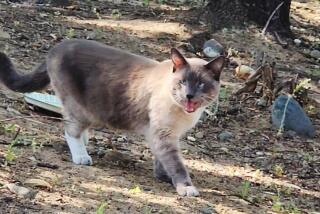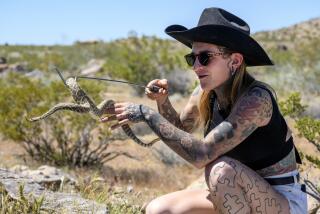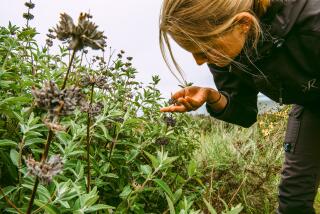She Brings Gift of Healing to Area Wildlife
- Share via
Somewhere near Rebecca Yates was a rattlesnake, and possibly an injured bobcat.
“You’re looking right at it,” a bystander yelled from the bottom of the hill. Yates, snake tongs in hand, studied the tree in front of her. Her assistant, Silvio Santinelli, searched unsuccessfully nearby.
They had received a call from Hathaway Children’s Services--located close to the Wildlife Waystation property in Angeles National Forest--that a bobcat had been bitten several times in a fight with a rattlesnake.
The bobcat may have run off and the snake could have been only five feet away. “I don’t know if you want to go up there,” another bystander said before the pair had headed up the hill.
But Yates, 37, the chief veterinarian at the refuge, was not afraid. She knew that rattlers do not attack unless directly threatened. She developed her love of snakes as a girl playing among the oil pumps in Windsor Hills, where she grew up. Her mother, although supportive, did not share her love of reptiles. “She just didn’t come into my room,” Yates said. “That was the rule.”
The Wildlife Waystation frequently gets calls that send Yates and her staff out in search of injured wild animals.
At the refuge, Yates has a responsibility for the health and well-being of more than 1,100 wild and exotic animals, including big cats, monkeys, bears and waterfowl--some rescued from abusive situations.
A resident of La Canada, she holds a bachelor’s degree from Cal State Humboldt, a master’s degree from Cal State Dominguez Hills and a doctor of veterinary medicine degree from UC Davis. She started working part-time at the volunteer-dependent refuge six years ago before becoming a full-time employee two years ago.
On the wall of the veterinary facility examining room is the phrase carved in wood, “Deeds, not words.” A white board lists wolves in need of spaying as well as scheduled castrations for a horse and llama.
The morning before the snake and bobcat search, Yates and Santinelli had spent an hour performing a vasectomy on an 85-pound chimpanzee. By noon, they had settled into a rhythm of small procedures, working as a team, with Santinelli holding the animals still as Yates operated.
Number 1360--a cotton-tailed rabbit--rested in a blue animal carrier with a yellow piece of paper attached. The note explained that the animal had been attacked by a cat in Sunland, leaving a dime-sized hole in its side.
Within a few minutes, Yates had cleaned the wound and sealed the opening using sterile veterinary glue.
Quickly following was a turtle brought in from Marina del Rey with a broken shell, possibly from being dropped. Yates applied an epoxy and fiberglass mixture to permanently seal the shell. Then she checked on a ferret recovering from the removal of a cancerous kidney and a brant--a type of waterfowl--that was on the mend from a broken wing.
If an animal cannot recover 90% of its strength and mobility, it has to be put to sleep, Yates said. Otherwise it would not be able to survive in the wild. Some animals can be kept at the refuge for educational programs, for example. But euthanizing is “the hardest part of my job,” she said.
On the other hand, there are moments that make the work worthwhile, especially when she works with reptiles, her favorites, like a 10-pound tortoise from which she removed a one-pound kidney stone. “She’s alive to tell about it,” Yates said.
And, the animal was placed in a home with a family. “That’s personally very satisfying to me,” Yates said.
More to Read
Sign up for Essential California
The most important California stories and recommendations in your inbox every morning.
You may occasionally receive promotional content from the Los Angeles Times.










